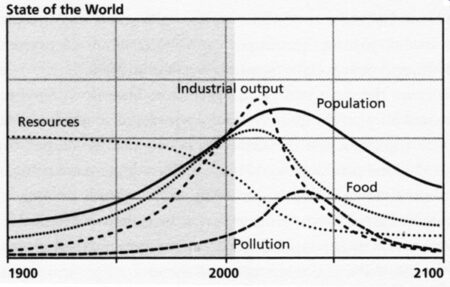In a world of finite resources and space, how can governments and human societies continue to preach growth? When we see Earth from space, and particularly when we see it further away than low-Earth orbit, we begin to understand what is meant by finite. There is only so much land, so much atmosphere, and so much ocean. And yet we treat all of it as if these are infinite and endless. Governments never stop talking about growing the economy as being the key to a better future. But it should be abundantly clear by now that growth as the principal objective of governments and businesses comes with consequences.
In 1972, a Massachusetts Institute of Technology (MIT) research project reported that growth without constraints would eventually lead to a crisis for humanity in the mid-21st century. The original study entitled, The Limits to Growth, was published by the Club of Rome. An analyst Gaya Herrington, a Ph.D. candidate from Harvard University, who is affiliated with KPMG, the professional services and accounting firm, recently took a return look at the study in light of the current pandemic, with questions about the risks of returning to a post-COVID19 world of unrestrained economic growth.
The MIT report which I remembered reading back in 1972 was seen as controversial. But looking at where we are today, and considering how we are polluting the air and water, and using up finite resources with impunity, the worst of the prophecies is ringing true. Today, we consume the resources of 1.6 Earths every year. That means the planet takes 20 months to recover and regenerate what is consumed annually. That is unsustainable mathematics, any way you look at it.
Herrington’s study posted on the KPMG site reviews the MIT report which offered 12 scenarios of how the future of growth and the planet would unfold. It predicted there would be a time when humanity would have to impose limits on growth or watch a debacle unfold. The scenarios were each given a name. Here we look at four of them: BAU, BAU2, CT, and SW.
BAU and BAU2 depict a world where standards of living and industrial growth plateau and begin to fall. BAU predicts a collapse caused by natural resource depletion. BAU2 doubles the amount of attainable natural resources but sees an inevitable collapse because of human-generated pollution (back in 1972 they didn’t talk about climate change). The end result for both foretells a dramatic decline in world population and quality of life.
The CT scenario is BAU2 on steroids. Steroids come from an infusion of technological advances. But even here the high cost of innovation is out of reach for much of humanity leading to plateauing: no collapse but a significant decline in the quality of life. SW is CT on steroids. In this model, humanity changes values and priorities. Population stabilizes with subsequent improvements in human welfare and the quality of life. Herrington, in the conclusion of her published paper, notes that the most desirable of the scenarios, SW “is…the one that aligned least closely with observed data.” She concludes, “the data most aligns with the CT and BAU2 scenarios which indicate a slowdown and eventual halt in growth within the next decade.” If she is right, we are not even talking 2040, but in the early 2030s.
In an interview with Motherboard, the online magazine, Herrington notes that The Limits to Growth worst-case scenarios did “not mean that humanity will cease to exist.” But it did foretell “economic and industrial growth will stop…which will hurt food production and standards of living” and lead to “a steep decline to set in.”
So when we talk about the limits of growth, what does that mean for the Developing World? One sees growth as a must to reduce poverty and inequality in countries that today don’t enjoy the standard of living seen by the wealthier few. Denying these nations an opportunity to grow and narrow the poverty gap on a planet that has seen consumption from these wealthier countries lead us to the projected outcomes described above is a sad commentary on our human condition.
One final note, The Limits to Growth didn’t factor in climate change in its analysis. It is unsustainable growth that has played such a significant role in rising carbon emissions. It would seem, therefore, that growth and climate change are incompatible. But maybe they are not if the former is sustainable growth. Sadly, within a decade or two we won’t have to predict anymore. We’ll be living the “limits.”

















[…] Growing the Economy is a False Narrative in a Resource and Climate-Change Constrained World […]